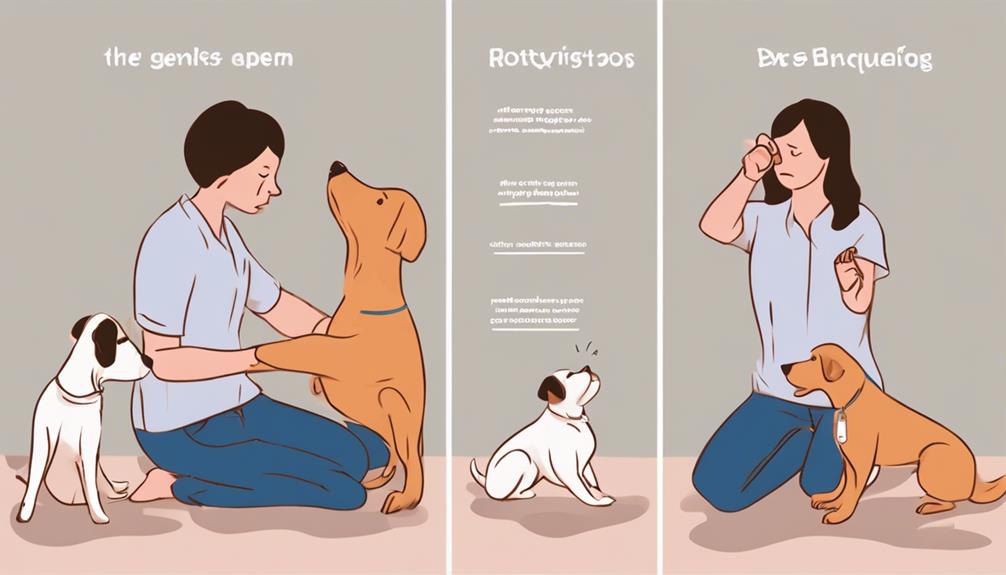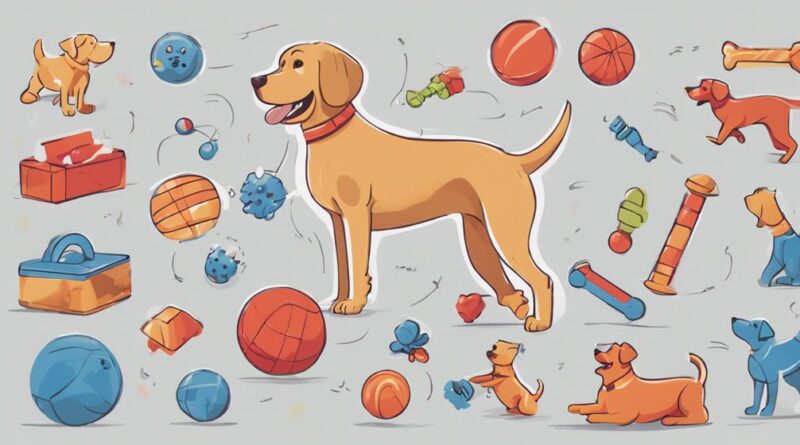Enhancing Dog Communication With Toy Interactions
Imagine the simplicity of a wagging tail and the complexity of a subtle ear twitch—dogs communicate with us in various ways.
But have you ever considered how toys could play a crucial role in this interaction? By choosing the right toys and engaging in play, you can unlock a deeper level of understanding and connection with your furry friend.
Through these interactions, a world of unspoken communication awaits, allowing for a bond that transcends mere words.
Importance of Toy Selection
When choosing dog toys, consider your pet's size, play style, and durability preferences to ensure safe and enjoyable interactions. Toy durability is crucial to prevent choking hazards or ingesting small parts that could harm your furry friend. Look for toys made from high-quality materials that can withstand your dog's chewing habits.
Interactive engagement is key for keeping your pet mentally stimulated and physically active. Toys that allow you to participate in playtime, such as tug-of-war ropes or interactive puzzle toys, can strengthen the bond between you and your dog. Additionally, consider the different textures and shapes of toys to cater to your pet's preferences.
Understanding Play Signals
To better engage with your dog during playtime, it's essential to understand their various signals and cues. Recognizing cues your dog gives during play is key to reinforcing positive behaviors and strengthening your bond. Dogs communicate through body language, vocalizations, and actions during play, providing valuable insights into their emotions and intentions.
When playing with your dog, observe their body language closely. A wagging tail, relaxed posture, and playful barks indicate enjoyment and excitement. Conversely, flattened ears, a tucked tail, or growling may signal discomfort or aggression. By recognizing these cues, you can adjust your play style to match your dog's preferences and ensure a positive experience for both of you.
Reinforcing positive behavior during play is vital for building trust and enhancing your dog's communication skills. Use treats, praise, or favorite toys to reward good behavior, such as following commands, sharing toys, or displaying friendly play gestures. This positive reinforcement encourages your dog to continue exhibiting desirable behaviors, creating a harmonious and enjoyable playtime for you and your furry companion.
Building Trust Through Play
Building trust with your dog through play involves consistent positive interactions that reinforce bonding and communication. Engaging in trust-building activities and incorporating play therapy can significantly enhance your relationship with your furry friend. Here are three key ways to build trust through play:
- Interactive Toys: Utilize toys that require teamwork and cooperation, such as tug-of-war ropes or puzzle toys. These activities encourage problem-solving and collaboration, strengthening the bond between you and your dog.
- Positive Reinforcement: Use play sessions as an opportunity to reward good behavior. Whether it's a tasty treat or extra playtime, positive reinforcement during play will help your dog associate fun interactions with trust and positivity.
- Consistency: Establish a regular play routine to create a sense of security and predictability for your dog. Consistent play sessions build trust by providing a reliable and enjoyable time for bonding and communication.
Incorporating these trust-building activities into your playtime routine can deepen your connection with your dog and enhance overall communication.
Enhancing Body Language Interpretation
To deepen your connection with your dog, observe and interpret their body language cues during play, enhancing the understanding and communication between you both. Improving observation skills is crucial in decoding what your dog is trying to express. Pay attention to their tail wagging speed, ear position, eye contact, and overall posture. These signals can convey a wealth of information about your furry friend's feelings and intentions. By honing your ability to read these cues, you can respond appropriately, fostering a deeper emotional connection with your pet.
Promoting emotional connection through body language interpretation is a powerful way to enhance your bond. When you understand how your dog is feeling during playtime, you can adjust your interactions to suit their mood. This level of attentiveness demonstrates care and empathy, strengthening the trust between you and your canine companion. Remember, dogs communicate primarily through non-verbal cues, so mastering the art of interpreting their body language is key to building a harmonious and fulfilling relationship.
Encouraging Positive Socialization
Promote a positive environment for your dog to socialize and interact with other pets, fostering healthy relationships and enhancing their social skills. Encouraging positive socialization is crucial for your dog's overall well-being. Here's how you can achieve this:
- Arrange Playdates: Organize play sessions with other friendly dogs to foster cooperation and social skills in your furry companion.
- Attend Training Classes: Enroll your dog in obedience or socialization classes to provide structured interactions, helping in developing empathy towards other animals.
- Visit Dog Parks: Take your dog to local dog parks where they can interact with various breeds, promoting socialization and enhancing their ability to understand and communicate with different personalities.
Promoting Cognitive Engagement
Encourage your dog's mental stimulation through interactive toys and engaging activities that challenge their cognitive abilities. Providing your furry friend with interactive games not only offers entertainment but also promotes mental stimulation. Introducing problem-solving activities into your dog's playtime routine can enhance their cognitive skills and keep their minds sharp. Interactive toys that require your dog to think, strategize, or perform certain actions can help in skill development and overall mental engagement.
Engage your dog in activities that involve puzzles, treat-dispensing toys, or hide-and-seek games to encourage problem-solving skills. These types of games can stimulate your dog's mind and provide a fun way to pass the time. By incorporating such activities into their daily routine, you can promote cognitive engagement and prevent boredom. Remember to rotate toys regularly to keep the activities fresh and exciting for your pup.
Through mental stimulation and interactive play, you can help your dog stay mentally sharp and content.
Addressing Behavioral Challenges

For effective management of behavioral challenges in your dog, consider implementing consistent training techniques tailored to address specific issues. Positive reinforcement is a powerful tool that can help shape desired behaviors in your furry friend. By rewarding good behavior with treats, praise, or playtime, you can encourage your dog to repeat those behaviors. Behavioral modification techniques, such as desensitization and counterconditioning, can be used to change unwanted behaviors by gradually exposing your dog to triggers in a controlled setting.
To address behavioral challenges in your dog effectively, follow these steps:
- Identify the Problem: Pinpoint the specific behavior you want to address, whether it's excessive barking, aggression, or separation anxiety.
- Develop a Training Plan: Create a structured plan that incorporates positive reinforcement techniques tailored to your dog's needs.
- Consistency is Key: Be patient and consistent in your training efforts to see long-lasting results in your dog's behavior.
Strengthening Human-Dog Bond
To deepen your connection with your dog, focus on strengthening the bond through daily interactions and shared activities. Training techniques play a crucial role in building trust and understanding between you and your furry companion. Consistent and positive reinforcement during training sessions not only helps your dog learn commands but also fosters a sense of teamwork and companionship.
Interactive games are another fantastic way to enhance the human-dog bond. Playing games like fetch, hide-and-seek, or tug-of-war can create moments of joy and excitement for both you and your dog. These activities encourage physical exercise, mental stimulation, and bonding through shared experiences. Additionally, interactive games provide an opportunity for you to observe your dog's behavior, preferences, and communication cues, further deepening your connection.
Incorporating training techniques and interactive games into your daily routine can strengthen the bond you share with your dog, creating a harmonious and fulfilling relationship built on trust, communication, and mutual respect.
Frequently Asked Questions
Can Certain Toys Help Address Specific Behavioral Challenges in Dogs?
Certain toys can indeed help address specific behavioral challenges in dogs. By incorporating toys into training routines, you can encourage behavioral modifications and provide solutions for problematic behaviors.
Toys can be used as positive reinforcements to redirect attention, provide mental stimulation, and promote physical activity. Choosing the right toys tailored to your dog's needs can play a significant role in improving communication and addressing behavioral issues effectively.
How Can Toy Interactions Be Used to Improve a Dog's Cognitive Abilities?
To improve your dog's cognitive abilities, engage in toy interactions. This fun activity boosts problem-solving skills as your canine companion figures out how to manipulate toys to get treats or rewards.
It also enhances sensory stimulation, encouraging mental alertness and curiosity. By incorporating interactive toys into your dog's routine, you provide mental exercise that can lead to a more engaged and mentally sharp pup.
Are There Any Tips for Introducing New Toys to a Dog and Encouraging Positive Socialization?
When introducing new toys to your dog, start by choosing toys that match their interests and energy level. Use positive reinforcement during training to encourage playtime and create a positive association with the toys.
Socialize your dog with the toys by engaging in interactive play sessions. Gradually introduce new toys to prevent overwhelming your pup.
What Are Some Common Mistakes People Make When Selecting Toys for Their Dogs?
When picking toys for your dog, some common errors include not considering toy durability and age appropriateness. Make sure toys are sturdy enough to withstand chewing and play.
Also, select toys that match your dog's age and size to prevent any safety hazards. By focusing on durability and appropriateness, you can ensure your pup enjoys safe and engaging playtime.
Can Using Toys to Enhance Body Language Interpretation Help Improve Overall Communication With a Dog?
When you engage in toy play with your dog, you can develop a deeper understanding of their body language cues. This increased awareness allows you to interpret their signals more accurately, leading to improved communication between you and your furry friend.
Conclusion
By actively engaging in toy interactions with your dog, you can strengthen your bond, improve communication, and address behavioral challenges.
Remember to choose toys that cater to your dog's preferences and play signals, and always prioritize positive reinforcement.
Through play, you can enhance your dog's cognitive engagement, promote socialization, and build trust.
So grab a toy, have fun, and watch as your relationship with your furry friend grows stronger every day.
